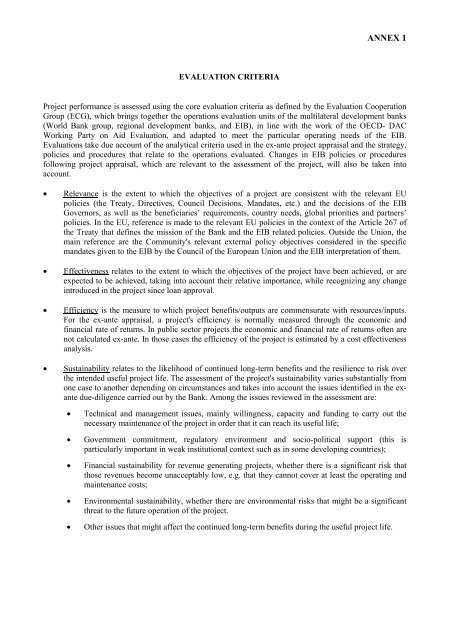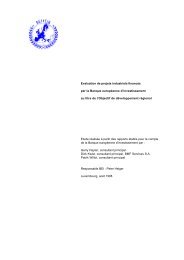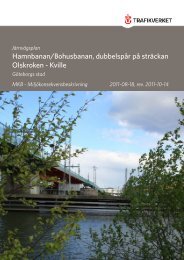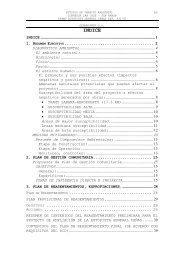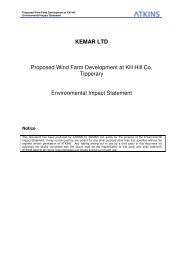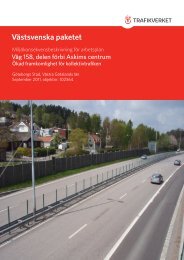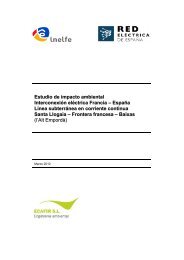Evaluation of Railway Projects in the European Union
Evaluation of Railway Projects in the European Union
Evaluation of Railway Projects in the European Union
Create successful ePaper yourself
Turn your PDF publications into a flip-book with our unique Google optimized e-Paper software.
ANNEX 1EVALUATION CRITERIAProject performance is assessed us<strong>in</strong>g <strong>the</strong> core evaluation criteria as def<strong>in</strong>ed by <strong>the</strong> <strong>Evaluation</strong> CooperationGroup (ECG), which br<strong>in</strong>gs toge<strong>the</strong>r <strong>the</strong> operations evaluation units <strong>of</strong> <strong>the</strong> multilateral development banks(World Bank group, regional development banks, and EIB), <strong>in</strong> l<strong>in</strong>e with <strong>the</strong> work <strong>of</strong> <strong>the</strong> OECD- DACWork<strong>in</strong>g Party on Aid <strong>Evaluation</strong>, and adapted to meet <strong>the</strong> particular operat<strong>in</strong>g needs <strong>of</strong> <strong>the</strong> EIB.<strong>Evaluation</strong>s take due account <strong>of</strong> <strong>the</strong> analytical criteria used <strong>in</strong> <strong>the</strong> ex-ante project appraisal and <strong>the</strong> strategy,policies and procedures that relate to <strong>the</strong> operations evaluated. Changes <strong>in</strong> EIB policies or proceduresfollow<strong>in</strong>g project appraisal, which are relevant to <strong>the</strong> assessment <strong>of</strong> <strong>the</strong> project, will also be taken <strong>in</strong>toaccount.• Relevance is <strong>the</strong> extent to which <strong>the</strong> objectives <strong>of</strong> a project are consistent with <strong>the</strong> relevant EUpolicies (<strong>the</strong> Treaty, Directives, Council Decisions, Mandates, etc.) and <strong>the</strong> decisions <strong>of</strong> <strong>the</strong> EIBGovernors, as well as <strong>the</strong> beneficiaries’ requirements, country needs, global priorities and partners’policies. In <strong>the</strong> EU, reference is made to <strong>the</strong> relevant EU policies <strong>in</strong> <strong>the</strong> context <strong>of</strong> <strong>the</strong> Article 267 <strong>of</strong><strong>the</strong> Treaty that def<strong>in</strong>es <strong>the</strong> mission <strong>of</strong> <strong>the</strong> Bank and <strong>the</strong> EIB related policies. Outside <strong>the</strong> <strong>Union</strong>, <strong>the</strong>ma<strong>in</strong> reference are <strong>the</strong> Community's relevant external policy objectives considered <strong>in</strong> <strong>the</strong> specificmandates given to <strong>the</strong> EIB by <strong>the</strong> Council <strong>of</strong> <strong>the</strong> <strong>European</strong> <strong>Union</strong> and <strong>the</strong> EIB <strong>in</strong>terpretation <strong>of</strong> <strong>the</strong>m.• Effectiveness relates to <strong>the</strong> extent to which <strong>the</strong> objectives <strong>of</strong> <strong>the</strong> project have been achieved, or areexpected to be achieved, tak<strong>in</strong>g <strong>in</strong>to account <strong>the</strong>ir relative importance, while recogniz<strong>in</strong>g any change<strong>in</strong>troduced <strong>in</strong> <strong>the</strong> project s<strong>in</strong>ce loan approval.• Efficiency is <strong>the</strong> measure to which project benefits/outputs are commensurate with resources/<strong>in</strong>puts.For <strong>the</strong> ex-ante appraisal, a project's efficiency is normally measured through <strong>the</strong> economic andf<strong>in</strong>ancial rate <strong>of</strong> returns. In public sector projects <strong>the</strong> economic and f<strong>in</strong>ancial rate <strong>of</strong> returns <strong>of</strong>ten arenot calculated ex-ante. In those cases <strong>the</strong> efficiency <strong>of</strong> <strong>the</strong> project is estimated by a cost effectivenessanalysis.• Susta<strong>in</strong>ability relates to <strong>the</strong> likelihood <strong>of</strong> cont<strong>in</strong>ued long-term benefits and <strong>the</strong> resilience to risk over<strong>the</strong> <strong>in</strong>tended useful project life. The assessment <strong>of</strong> <strong>the</strong> project's susta<strong>in</strong>ability varies substantially fromone case to ano<strong>the</strong>r depend<strong>in</strong>g on circumstances and takes <strong>in</strong>to account <strong>the</strong> issues identified <strong>in</strong> <strong>the</strong> exantedue-diligence carried out by <strong>the</strong> Bank. Among <strong>the</strong> issues reviewed <strong>in</strong> <strong>the</strong> assessment are:• Technical and management issues, ma<strong>in</strong>ly will<strong>in</strong>gness, capacity and fund<strong>in</strong>g to carry out <strong>the</strong>necessary ma<strong>in</strong>tenance <strong>of</strong> <strong>the</strong> project <strong>in</strong> order that it can reach its useful life;• Government commitment, regulatory environment and socio-political support (this isparticularly important <strong>in</strong> weak <strong>in</strong>stitutional context such as <strong>in</strong> some develop<strong>in</strong>g countries);• F<strong>in</strong>ancial susta<strong>in</strong>ability for revenue generat<strong>in</strong>g projects, whe<strong>the</strong>r <strong>the</strong>re is a significant risk thatthose revenues become unacceptably low, e.g. that <strong>the</strong>y cannot cover at least <strong>the</strong> operat<strong>in</strong>g andma<strong>in</strong>tenance costs;• Environmental susta<strong>in</strong>ability, whe<strong>the</strong>r <strong>the</strong>re are environmental risks that might be a significantthreat to <strong>the</strong> future operation <strong>of</strong> <strong>the</strong> project.• O<strong>the</strong>r issues that might affect <strong>the</strong> cont<strong>in</strong>ued long-term benefits dur<strong>in</strong>g <strong>the</strong> useful project life.


